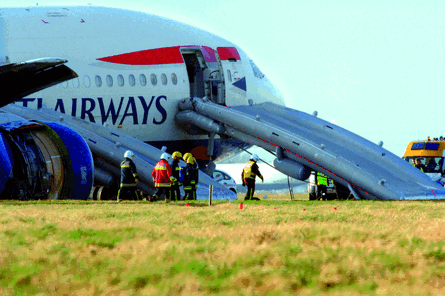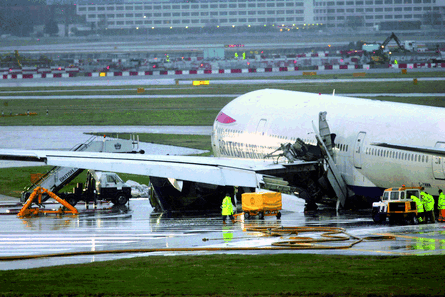Seldom does an investigation team have to hunt so intensely for a one-in-a-million circumstance that might explain a moment of unexpected, potentially catastrophic aircraft behaviour. Eight months on and it appears the prime suspect into the British Airways Boeing 777-200ER crash-landing at London Heathrow has, quite literally, melted away.
In the 13 years since service- entry no carrier had suffered the loss of a 777, and the crippling of BA038 from Beijing on 17 January quickly became seen as an extraordinary event that would demand an extraordinary explanation. Risk of dual-engine roll-back during take-off on General Electric GE90-powered 777s, linked to erroneous full-authority digital engine control commands, had been the subject of an emergency airworthiness directive less than two years earlier. But the BA aircraft was fitted with Rolls-Royce Trent 800s and had experienced dual roll-back on final approach.
 |
|---|
© Keith Hammett |
Within 7s of the right-hand engine pressure ratio falling to 1.03, that of the left-hand engine dropped to 1.02, the result of fuel-flow being less than that commanded by the autothrottle. In a bid to stretch the sudden glide, the crew reduced flap from 30° to 25° and pitched the twin-jet nose-down. It struck the ground, short of runway 27L, while descending at 1,400ft/min (7m/s).
COMPLEX INQUIRY
"This is a complex, technical inquiry," says UK Air Accidents Investigation Branch chief inspector David King. Some 141,000 individual flights by 777 aircraft have been examined, including in-depth analysis of fuel-flow rates on 13,000 undertaken by Trent-powered airframes, as investigators increasingly concentrated on the possibility that a familiar external threat to air transport - ice - had, in this case, become an internal one.
Extreme cold had characterised the flight. BA038 had received 71.4t of China's equivalent of Jet A-1 fuel at Beijing. In the left main tank the fuel temperature registered -2°C (24.8°F) on departure and, as the jet cruised initially at 34,750ft (10,600m), it cooled to -32°C.
Six and a half hours into the flight a step-climb took the 777 to 38,100ft, the static air temperature fell sharply to a low of -73°C, and the fuel dropped to -34°C where it stayed for 80min. On just 0.2% of the flights analysed by the inquiry had the fuel temperature fallen below this level.
"This data-mining work is ongoing and is exploring further combinations of parameters to identify unique features from the accident flight," says King.
Investigators noted that the step-climb had been performed at a gentle 400ft/min using the autopilot's vertical-speed mode. A similar climb, towards the end of the cruise, took the 777 to 40,000ft.
Neither climb raised the fuel-flow rate much above 4,000kg/h (8,810lb/h) for either engine, which meant that this rate did not peak significantly until final approach when the autothrottle stabilised the airspeed with a series of four commands, in relatively quick succession, to increase thrust. The second of these took the peak fuel-flow to around 5,500kg/h. During the fourth thrust command the engine roll-back began.
Investigators found that step-climbs at relatively low fuel-flow rates and approaches with relatively high rates each made up only a relatively small proportion of the 13,000 analysed flights by Trent-powered 777s.
While the conditions experienced on BA038 were not unique, the AAIB points out: "When analysed in conjunction with the fuel temperature dataall of these factors make this flight unusual."
Fresh cavitation marks on the outlet ports of both engines' high-pressure pumps, the only physical evidence of the cause, indicated a restricted fuel flow. With fuel waxing ruled out, water icing is the focus of attention.
Jet fuel normally contains a certain amount of water. As fuel cools it also releases dissolved water into a suspended state. While this water starts crystallising below -1°C, and develops adhesive properties as it cools further, the investigation has yet to determine a mechanism to cause the restriction on BA038.
Intensive testing on a special rig has attempted to replicate a blockage in the fuel path between the tank, through the boost pumps, to the engines' low-pressure pump, fuel/oil heat exchanger and high-pressure pump.
 |
|---|
© Jeff Moore |
Ice originating in the fuel tank is "unlikely" to have been the source, says the AAIB, and ice build-up inside fuel pipes and the boost-pump inlet screens does not appear capable of restricting flow.
Water-injection experiments have shown that ice can accrete on the face of the fuel/oil heat exchanger, but this has only been achieved by using water concentrations "considerably in excess" of certification limits. Ice on the heat exchanger also tends to melt at low fuel flows - such as those during descent - and BA038's fuel system appeared unaffected when the autothrottle began stabilising the final approach.
Gradual accretion, to the point of constriction, has yet to be ruled out. But a second possible scenario proposes that accreting ice, built up in the cold cruise, was suddenly flushed downstream by the autothrottle command to increase fuel-flow. The ice became caught and blocked the flow.
No final conclusions have yet been drawn.
But an interim inquiry report on 4 September directed US and European authorities to assess certification requirements to ensure fuel systems are "tolerant to the potential build-up and sudden release" of ice.
It also recommends interim measures to reduce the risk of icing in Trent-powered 777s. Rolls-Royce says: "The focus is on Trent-powered 777s because that's the combination in the incident."
But General Electric, which manufactures the rival GE90 powerplant, says the two engines have differing fuel-system architectures, notably in the location of the main fuel/oil heat exchanger.
These differences lead to a difference in fuel temperature at the inlet of the heat exchanger. GE adds: "There are no anticipated field actions for the GE90-powered 777s."
The AAIB is more cautious, stating: "Testing and research into this, apparently hitherto unknown, phenomenon has only been conducted on the Boeing 777 installed with Trent 800 engines, and it is unknown whether other aircraft and engine types may also be susceptible."
But Boeing says: "What's come out of the analysis is that [other 777 engines] are not subject to this condition." It has issued three operational recommendations in the wake of the findings, two of which apply to 777 in-flight operations.
 |
|---|
The Boeing 777 has two main wing tanks, which are more exposed to cold air at high altitude. When the fuel temperature in these tanks is below -10°C, says Boeing, the crew should induce "periodic" climbs to higher altitudes using maximum thrust, achievable through using the flight-management system's vertical navigation function.
Boeing's second advisory applies to flights which have maintained the same altitude for at least 3h. Before descent, if the fuel temperature is below -10°C, the pilots should advance the throttles to maximum thrust for 10s or until the airspeed reaches Mach 0.86.
The third recommendation focuses on refuelling operations on the ground. It states that, if the fuel in the main tanks is not expected to rise above 0°C before the next flight, the fuel pumps should be run for a maximum of 1min.
All these operational advisories are designed to minimise the risk of water-ice building up inside the fuel system during cruise, and being released in quantities capable of overwhelming the ability of the engines' fuel/oil heat exchanger to melt it.
British Airways has already instructed its 777 crews accordingly but the carrier is also shifting its scheduling to minimise the number of back-to-back sectors flown by 777s through regions of particularly cold weather. Flight International understands that these precautions, in practice, are being applied to the Trent-powered 777 fleet.
Consideration is being given to en route conditions, the carrier says, and individual aircraft could be switched to different routes, after completing a return sector, to avoid prolonged exposure to fierce cold.
While the mystery of BA038 remains officially unsolved, the AAIB has highlighted the longer-term ramifications of the icing scenario.
"Although the exact mechanism in which the ice has caused the restriction is still unknown, in detail, it has been proven that ice could cause a restriction in the fuel-feed system," it says. But changing a fuel system design to increase tolerance to icing is seen only as a distant prospect.
The AAIB has suggested anti-icing additives, such as the diethylene glycol compound known as Prist, as a possible alternative. In aircraft without fuel-line heating systems, such additives - in concentrations of 0.1-0.15% by volume - act to reduce the freezing point of free water in fuel.
Originally developed to prevent ice-induced roll-back on Boeing B-52 bombers, anti-icing additives have been in use for decades.
"The military uses it for a lot of their equipment," says Prist Aerospace Products' Joe Mattingly, pointing out that this includes large transport aircraft. Certain executive jet types also routinely use additives. "It has to be blended at a critical point but that's a standard operation," says Mattingly.
But he adds that airlines do not have ready access to the necessary infrastructure. "It's another cost," he says. "Plus the logistics of getting it set up - that's probably an issue today."
Keep up to date with the BA 777 crash inquiry findings at flightglobal.com/ba777
Source: Flight International























